| Srl | Item |
| 1 |
ID:
090673
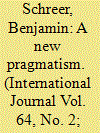

|
|
|
|
|
| Publication |
2009.
|
| Summary/Abstract |
The analysis here examines the major factors leading to a change in Germany's approach towards the alliance. It proceeds in three broad steps. First, evidence for a shift in German NATO policy is provided. Second, the most important external and domestic factors affecting German behaviour in NATO are identified. In the final section, some predictions for future German NATO policy are made, as well as some implications for the alliance as a whole.
|
|
|
|
|
|
|
|
|
|
|
|
|
|
|
|
| 2 |
ID:
133369
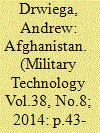

|
|
|
|
|
| Publication |
2014.
|
| Summary/Abstract |
A complete analysis of ISAF's combat commitment within Afghanistan is impossible to summaries in a single article; but, by focusing on specific campaign factors, some lessons for the future can be discerned while a little more time remains with boots on the ground.
|
|
|
|
|
|
|
|
|
|
|
|
|
|
|
|
| 3 |
ID:
127660
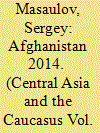

|
|
|
|
|
| Publication |
2013.
|
| Summary/Abstract |
The continuing destabilization of public life in Afghanistan and far from always successful attempts by the International Security Assistance Force (ISAF) to return it to normal are creating fundamental challenges and threats to regional and global security.
The following problems can be identified:
1. Higher drug production and circulation. This is causing a steady rise in both the number of people dependent on heroin and opiates coming from Afghanistan and the total number of drug addicts (according to experts, 36,000 young people die from drugs in Russia every year).
2. Stronger transnational crime groups in Central Asia (CA). Their activity is closely related to the drug business and movement of drugs from Afghanistan to Russia and Europe through the Central Asian countries.
3. Continued presence of armed U.S. and NATO forces in Afghanistan and its neighboring states in the form of their network of super bases is not helping to combat the threat of terrorism.
In recent years, it has become obvious that the CA states are facing a complex problem manifested in a dramatic deterioration of the internal situation in Afghanistan and Pakistan; an increase in the fragmentary Talibanization factor; similar situations in the border areas of Afghanistan and Pakistan; and an aggravation of the Pashtun issue.
The problem is that some of the former ideas about what is going on in Afghanistan do not correspond to current reality. It is incorrect to take the simplified approach and reduce the entire problem to the existence of the Taliban movement, under which all those drawn into the struggle against the ISAF in the wake of various ideas and slogans are lumped. Several Taliban centers function in Afghanistan and Pakistan (radical, extremist, and moderate).
The policy of the CA states should not be limited to endowing the large nations with the right to resolve the Afghan-Pakistani problems. States with interests in the country that are capable of having an impact on the development of the situation must also be engaged to untie the "Afghan knot"; the matter primarily concerns Russia, China, Iran, and the CA countries.
|
|
|
|
|
|
|
|
|
|
|
|
|
|
|
|
| 4 |
ID:
137454


|
|
|
| 5 |
ID:
127873
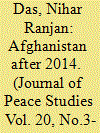

|
|
|
| 6 |
ID:
127875
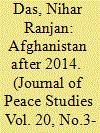

|
|
|
| 7 |
ID:
125283
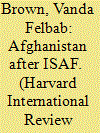

|
|
|
|
|
| Publication |
2013.
|
| Summary/Abstract |
Summer 2013 brought one of the most violent fighting seasons in Afghanistan since the US military and state-building effort began in 2001. On the cusp of the momentous 2014 presidential elections and a year before the majority of international coalition forces would depart from the country in the midst of transferring security functions to the coalition-supported Afghan National Security Forces (ANSF), the Taliban is dug in and still ferocious. It is testing the Afghan security forces, which since June 2013 are supposed to be taking the lead in providing security throughout the country while international forces are increasingly disengaging from combat and departing Afghanistan.
|
|
|
|
|
|
|
|
|
|
|
|
|
|
|
|
| 8 |
ID:
112822
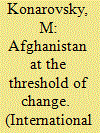

|
|
|
|
|
| Publication |
2012.
|
| Summary/Abstract |
ON DECEMBER 5, 2011, Bonn hosted a large-scale International Afghanistan Conference under the slogan "Afghanistan and the International Community: From Transition to the Transformation Decade" attended by high representatives of about 100 countries and international organizations, in short, practically the entire range of the world community. The conference met to look at ten years of post-Taliban development and reconfirm a broad international consensus on the Roadmap of the country's development after the draw-down of American and NATO contingents launched in the summer of 2011 and expected to be completed in 2014.
|
|
|
|
|
|
|
|
|
|
|
|
|
|
|
|
| 9 |
ID:
119087
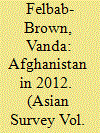

|
|
|
|
|
| Publication |
2013.
|
| Summary/Abstract |
As the 2014 transition of the U.S. out of Afghanistan approaches, progress has been made in weakening the Taliban insurgency and strengthening Afghan forces' capacity. But the Taliban still remains entrenched, negotiations have not taken off, the Afghan government suffers from a profound legitimacy crisis, and Afghanistan's economic future seems fraught with instability.
|
|
|
|
|
|
|
|
|
|
|
|
|
|
|
|
| 10 |
ID:
154421
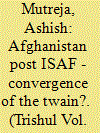

|
|
|
| 11 |
ID:
117109
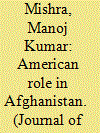

|
|
|
| 12 |
ID:
117110
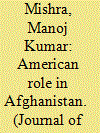

|
|
|
| 13 |
ID:
104389
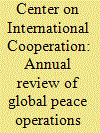

|
|
|
|
|
| Publication |
Boulder, Lynne Rienner Publishers, 2010.
|
| Description |
x, 375p.
|
| Standard Number |
9781588267375
|
|
|
|
|
|
|
|
|
|
|
|
Copies: C:1/I:0,R:0,Q:0
Circulation
| Accession# | Call# | Current Location | Status | Policy | Location |
| 055990 | 327.172/CEN 055990 | Main | On Shelf | General | |
|
|
|
|
| 14 |
ID:
113110
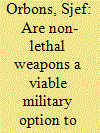

|
|
|
|
|
| Publication |
2012.
|
| Summary/Abstract |
Commanders of the International Security Assistance Force (ISAF) have repeatedly stressed the hearts and minds approach in Afghanistan, in saying that the human terrain is decisive for a successful outcome of the mission. Avoidance of civilian casualties is considered of strategic importance, and by nature highly dependent on the management of tactical level Escalation of Force (EoF) situations. Non-lethal weapons (NLWs) are expected to enable tactical commanders to avoid innocent civilian casualties in such situations. This article considers a selected NLW on its potential to accomplish this requirement. It uses a defence technology assessment approach to analyse EoF situations experienced by Dutch ISAF forces in which the NLW is inserted. The analysis demonstrates that a range of contextual factors in the Afghanistan high-risk environment tend to narrow down the window of opportunity for the NLW to help defuse the risk of unintended civil casualties.
|
|
|
|
|
|
|
|
|
|
|
|
|
|
|
|
| 15 |
ID:
131985
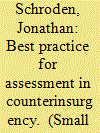

|
|
|
|
|
| Publication |
2014.
|
| Summary/Abstract |
In September 2011, the Commander of the International Security Assistance Force (ISAF) in Afghanistan directed the Afghan Assessment Group to redesign the way in which ISAF was assessing the status of the war, and to be 'revolutionary' in so doing. The resulting assessment paradigm was novel, non-doctrinal, and effectively addressed the unique complexities of the counterinsurgency in Afghanistan and the needs of the ISAF Commander. It had a two-tier structure consisting of both strategic and campaign assessments. The former focused on answering a set of strategic questions in narrative, analytic form to address the strategic environment, while the latter used a set of standards and accompanying narrative responses to gauge accomplishment of campaign tasks. Both tiers captured the current state of the war while maintaining an eye on future challenges and opportunities. The two assessments and their associated processes were designed to stimulate discussions leading directly to decisions by senior leaders on actions they could take, direct, or request. While any assessment paradigm will have advantages and disadvantages, an examination of the pros and cons of this assessment paradigm makes clear that it should be considered a 'best practice' in the field of counterinsurgency assessment.
|
|
|
|
|
|
|
|
|
|
|
|
|
|
|
|
| 16 |
ID:
130399
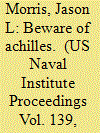

|
|
|
| 17 |
ID:
127659
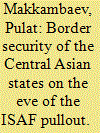

|
|
|
|
|
| Publication |
2013.
|
| Summary/Abstract |
For over 30 years now, the conflict in Afghanistan has been and remains a source of international and regional instability. The crisis developments emerging in the territory of this country threaten the border security of the Central Asian states; what will happen in Afghanistan after the ISAF pullout is causing even more concern.
The author analyzes the impact of the Afghan conflict on the border security of the Central Asian states and concludes that bilateral and multilateral efforts to preserve border security should be improved to stave off the threats that might emanate from Afghanistan.
|
|
|
|
|
|
|
|
|
|
|
|
|
|
|
|
| 18 |
ID:
096704
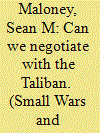

|
|
|
|
|
| Publication |
2010.
|
| Summary/Abstract |
The belief that the insurgency in southern Afghanistan is a singular entity and the assumption that negotiations with that entity can bring an end to the conflict are simplistic and do not take into account the other insurgent partners, nor the role of local power brokers. Care must be taken when providing advice in the public domain on how to end or limit conflict in Afghanistan.
|
|
|
|
|
|
|
|
|
|
|
|
|
|
|
|
| 19 |
ID:
141370
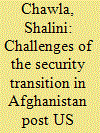

|
|
|
|
|
| Summary/Abstract |
The announcement of the spring offensive by the Afghan Taliban was followed by a series of deadly attacks in Afghanistan, including the attack on the Afghan Taliban and the Agust 4 attacks in Kabul, making the security environment even more complex.
|
|
|
|
|
|
|
|
|
|
|
|
|
|
|
|
| 20 |
ID:
109557
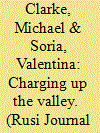

|
|
|